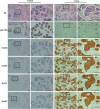miR-200b as a prognostic factor in breast cancer targets multiple members of RAB family
- PMID: 24447584
- PMCID: PMC3898994
- DOI: 10.1186/1479-5876-12-17
miR-200b as a prognostic factor in breast cancer targets multiple members of RAB family
Abstract
Background: miR-200b has been reported to be a tumor suppressor and a promising therapeutic target in cancer. miR-200b has been associated with epithelial-mesenchymal transition and chemo-resistance in cancer. The aim of this study is to investigate the expression of miR-200b, its prognostic roles and its potential targets in breast cancer.
Methods: qRT-PCR was used to detect miR-200b expression in breast cancer tissues and cell lines. In situ hybridization of miR-200b on tissue microarray including 134 breast cancer samples was used to evaluate its prognostic role. Novel targets of miR-200b in breast cancer were predicted and confirmed by luciferase reporter assay and western bloting. Immunohistochemical staining was used for protein detection. The biological effects of miR-200b in breast cancer cells were further confirmed by ectopic expression of its mimics followed by MTT assay and invasion test.
Results: miR-200b was downregulated in breast cancer tissues and cell lines and its low-expression correlated with poor outcome in breast cancer patients. Members of RAB family, RAB21, RAB23, RAB18 and RAB3B were predicted to be the targets of miR-200b. The luciferase reporter assay was performed to certificate this prediction. The expressions of RAB21, RAB23, RAB18 and RAB3B were suppressed by transfection of miR-200b in breast cancer cells. Over-expression of miR-200b or knock-down of RAB21, RAB23, RAB18 and RAB3B inhibited breast cancer cell proliferation and invasion in vitro.
Conclusions: Our study provides evidence that miR-200b is a prognostic factor in breast cancer targeting multiple members of RAB family. MiR-200b could be a potential therapeutic target in breast cancer.
Figures





References
-
- Carey LA, Perou CM, Livasy CA, Dressler LG, Cowan D, Conway K, Karaca G, Troester MA, Tse CK, Edmiston S. Race, breast cancer subtypes, and survival in the Carolina Breast Cancer Study. JAMA: the journal of the American Medical Association. 2006;295:2492–2502. doi: 10.1001/jama.295.21.2492. - DOI - PubMed
Publication types
MeSH terms
Substances
LinkOut - more resources
Full Text Sources
Other Literature Sources
Medical

